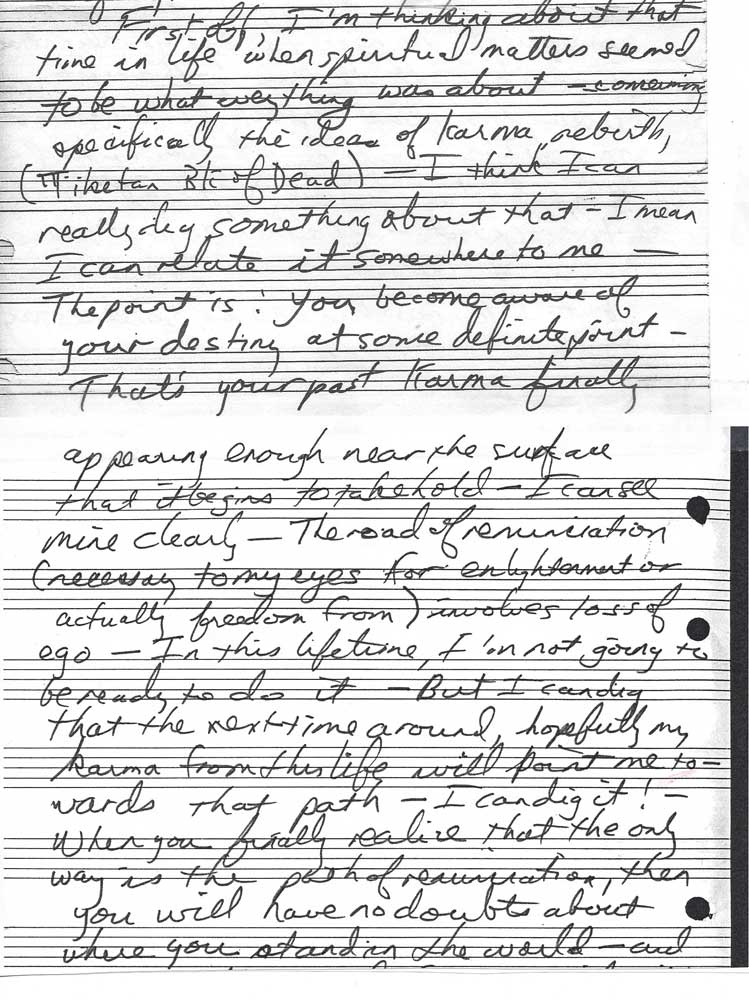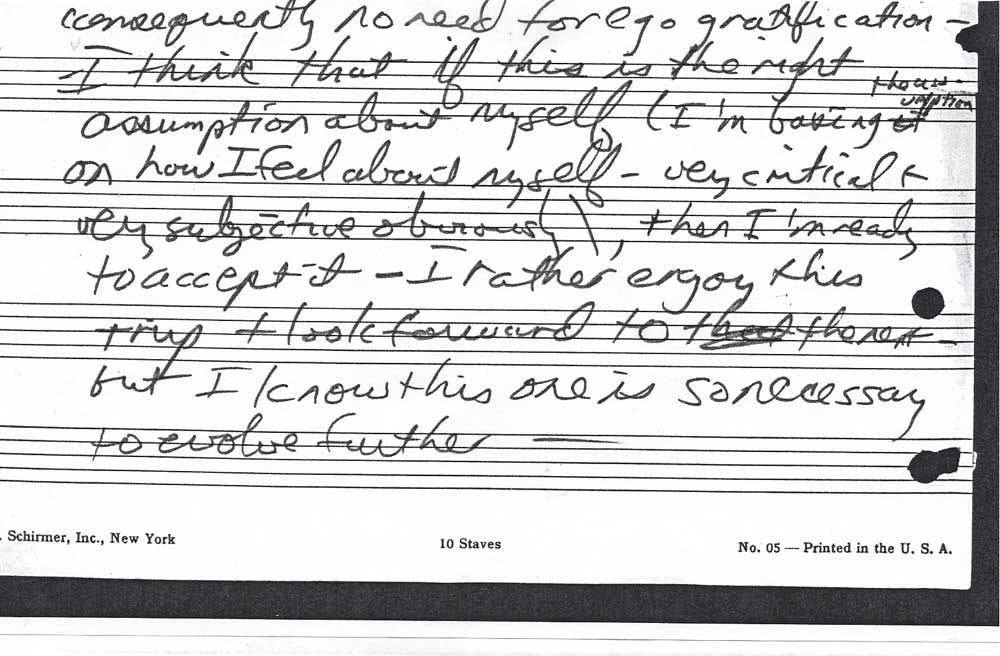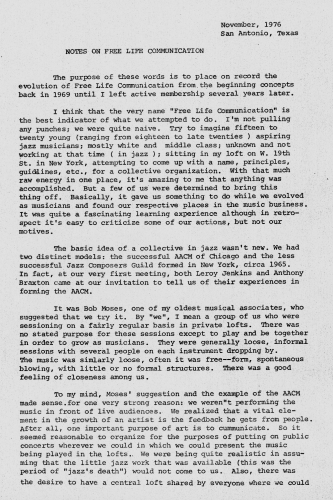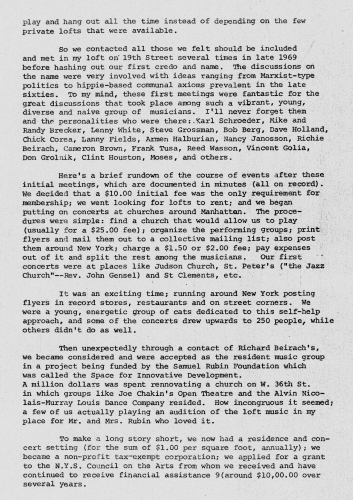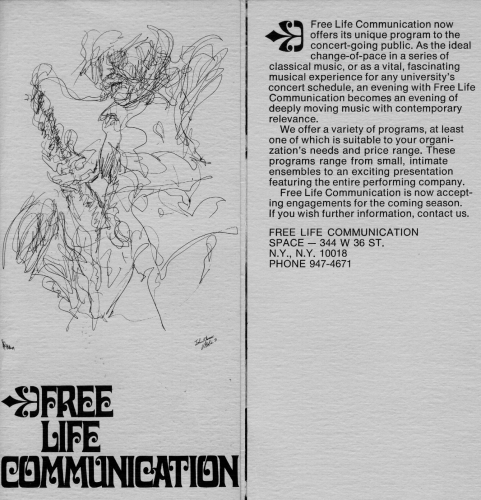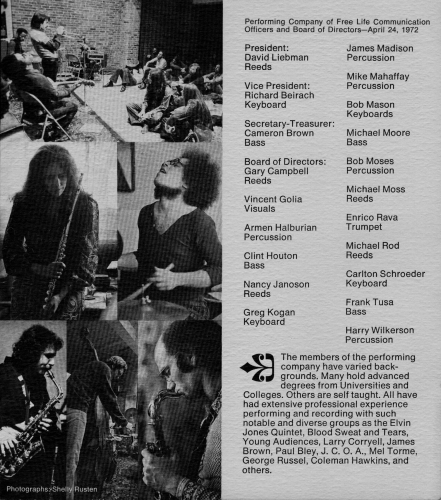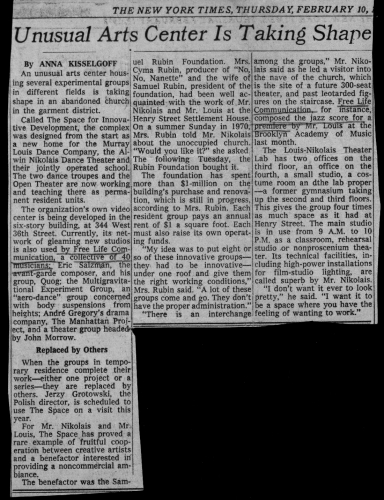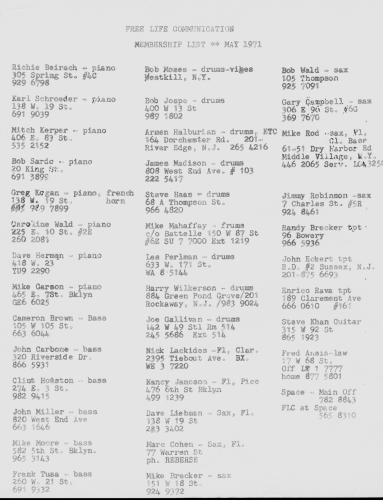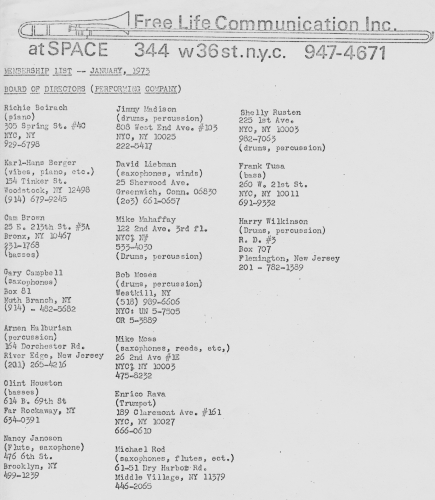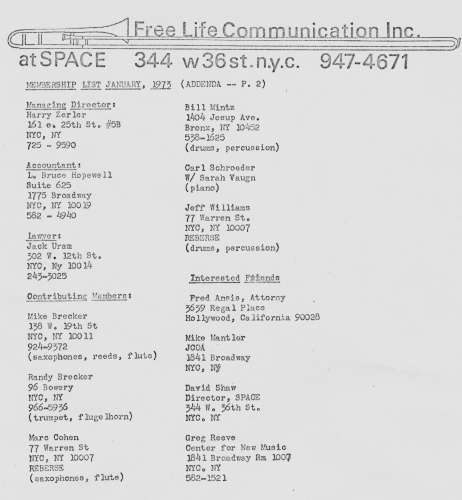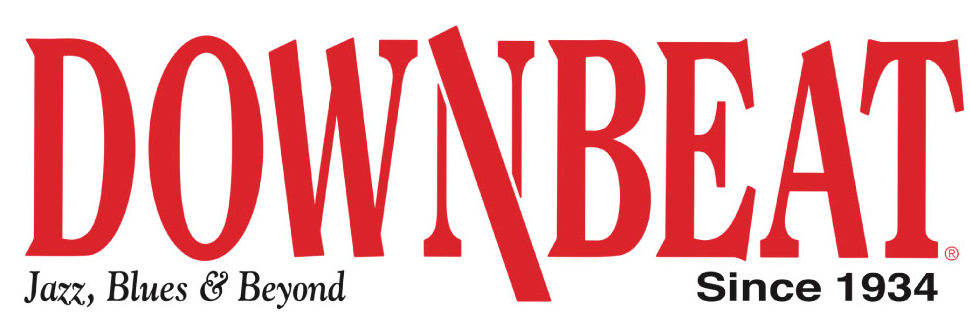by DAVID LIEBMAN
Following is a transcription of a talk that I gave to a class of students at East Stroudsburg University(Pennsylvania) for the conclusion of a course titled “Masters of Jazz”. For twelve sessions guest musicians spoke about their lives to the students. The textbook for the course was my “Self Portrait of A Jazz Artist” (Advance Music) The topic for the talk was to describe understand the common qualities that these artists possess which define success in jazz and in life.
I wrote down a few of what I would describe as common qualities that you saw in these speakers, in various intensities, that you will find in the real world no matter what you do, no matter what field you encounter. I think there are some general lessons here that you can observe and then there are some very unique things that we only see so with such intensity in the jazz field.
One of the things I really admire about the musicians, maybe the main thing is that the musicians and people involved in jazz are in it for the music and possess a certain kind of — I’m going to say it slang-wise — a certain kind of down-home, informal quality…straight-forward vibe basically, just plain folks. These are the kind of people you can talk to anywhere. This is not to disparage any other field or any other kind of music, but the idea of the prima donna, the idea of the “great artist” sitting in an ivory tower aloof and away from the real world for the most part really doesn’t exist among jazz musicians. It’s just not in their “M.O.” I think that is something we really value. I’m not saying that they’re not sometimes quite introspective and like their privacy and so forth, but they’re the kind of people who don’t holds airs or come on strong with an attitude. To me, that’s a very endearing quality in common with all the jazz musicians I’ve met. And by the way, this is true all over the world regardless of language. That’s a nice thing to see and something that I feel anyone would prefer to encounter in the real world but of course that isn’t always going to be the case. This is definitely something in common with the artists you have seen here.
Another thing that you might have noticed, again depending on what each of the people spoke specifically about, meaning what the emphasis of their discussion with you was, is how the word “integrity” enters into the life of these artists. Integrity is a word that gets bandied around a lot and means different things to different people of course. But I think for the most part what you saw are people who are so true and connected to what they do that it would be very difficult to imagine them moving from that place. Their ways of achieving what they want are going to be, for the most part, honest, moral and ethical. And that is I would say, a very common trait among jazz musicians. They are very straight, honest people in that respect with no game-playing. These are not the kind of people that are going to take the money and run. For the most part there is a real honesty about intentions and personal dealings.
What is it that makes these common traits among people who come from all different experiences? I always go back to the fact that the music is the source of the truths and our principles. In other words, what we heard, and you heard everybody talk about their influences — who inspired them, how they started, what gave them the idea to even play — what you find in the music is usually something much higher and much more spiritual, much more balanced than your life or the life you see around you. The music is perfect, after that it’s what we bring to the music. When you listen to those who inspired you, you are turned on by the beauty, the logic, all the great intellect and the great technique. That beauty that comes through the music I have always felt showed me a better way to be as a person. In other words, if I had a doubt about how to be, I would listen to Coltrane who would straighten me out, especially when I was in that period of my life searching for how to be which was my early 20s for the most part. In other words, when questions arose about which way I should go, the kind of things that one confronts in life, when I would listen to Coltrane, it would make me say: “Well there’s no question about which way I have to follow.” So there’s something about the music that gives a sense of integrity and direction to those who love and devote themselves to it. This is a definite common trait.
More to the practical world. I read a book years ago called The Lives of the Great Composers. It was by a very famous critic from the New York Times, Harold Schoenberg, a classical music critic, very respected and so forth. It was biographies of all the guys from, you know, Mozart right on through the modern ones. I remember my impression of the book was how different everybody was in the way they organized music. Some were completely organized, I forget, it was one of the H’s – Handel or Haydn, one of those guys was so organized; he had everything together, everything was copied, parts were together, and he would hand it to the King or whomever and that would be it. One of the other dudes, Debussy or somebody, was up at 5 in the morning the night before it was due, copying the parts. I’m talking all geniuses, all great, all different paths to the same thing. A quality you see among all these musicians, a quality you can glean from all of these speakers is some sense of organization. Now, if you were to compare the organization of Speaker A with the organization of Speaker B and go to their studio, you’d see one guy’s studio where there are saxophones in the corner on the floor, reeds, music paper, pencils strewn all about, and go to some other studio and everything is in boxes and neatly stacked. This would reflect an obvious difference in the style. But I think, beyond the style, beyond the way one does it, for somebody to be able to play and be involved in this music, you have had to be organized somewhere, somehow. Because there’s no way that you could amass this kind of information, to be able to spit it out in a spontaneous way in such rapidity that we do in jazz without being organized in some fashion. I mean like a computer. The boxes in the brain are divided up into little segments which work. They’re different for everybody but they are very, very clear. There’s no way that they would get to this kind of level if they weren’t like that.
Another thing that’s in common, that goes along with the organization principle, is the ability to project, to think ahead, to imagine. It’s thinking about a situation, about what will it be like, what is happening tomorrow, what will the music sound like if I do this, where will the music be played, etc. In other words, what we spend a lot of our time doing is preparing for the next event, whether it’s a gig, or writing for a recording, or traveling, or organizing a tour. These are very practical things. Or maybe I am preparing to learn something so that possibly in a year or two I’m very good at it. In other words I’ll learn this piece and then I’ll get better through the discipline I’ve learned by studying. A musician has to be able to imagine what things are going to be like, to project and not be afraid of the future, or be scared about how it will sound…just go out on a limb. In a way, that’s very tied to the spontaneous nature of what we do, that we’re playing on the spot, in the moment and we’re not sure how it’s going to work out. But even more than that, even away from the instrument, it is the ability to really look ahead and say “What would happen if I did this? And if I do this, what would the results be?” That’s a certain kind of ability. I don’t know if that comes through the music or that comes because of the music, but I think that is in common to a lot of jazz musicians — the ability to project ahead into the future.
Obviously a big thing, and this you probably got very clearly from all the speakers as they spoke about their past and their lives and how they developed is the ability to learn from experience. How to take a kernel of information and let that be a lesson to do something better the next time. Now we do it every minute with the music. If we see a chord change, or we see a new pattern, or we see something musically that is thrown in front of us that is unusual, the way we handle that is a preparation for the next time that comes up. We may not realize it but of course we’re honing our abilities…we’re disciplining ourselves every time we see that particular problem. One might say: “Well you know what, I saw this chord progression which was very difficult in this tune that I did on a recording date. I got through it but it was a bitch to play. I’m taking it home, I’m going to practice it and write 20 extra exercises on it to make a study out of it.” Well, that’s quite organized and very, very disciplined. Another person might just be more spontaneous about it, in the sense of saying: “Well you know that thing I saw yesterday in the music was quite challenging and I will remember that and lodge it in that part of the brain that I can use for experience.” That’s very important…to learn from experience. We do it with the music, which is no different from anybody in any other part of life who learns from experience.
But that’s what’s unusual about us. What’s different from other people in this respect is that the music made us become this way. That’s how I feel about it. It wasn’t like we came on to the planet with these things. We came in as anybody else, equipped with whatever our past is and whatever our upbringing was. But when we got to the music, usually at a very impressionable age, it told us these things without even spelling it out. So they’re all things we got from music and then of course those that are smart enough or that are aware will take these things and develop them further.
Of course you know that one of the elements of jazz is what we call spontaneity, spontaneous improvisation. The whole idea of spontaneity and flexibility, the ability to change in mid course and alter plans, not be upset, to try something different on the spot, in the moment, is really something that’s a good attribute to have in life because we can’t tell what’s going to be coming down the road. In jazz, again, the music demands that we are like that on a musical level. You have to be like that, otherwise we couldn’t handle this music. We’d be better in classical music, which is knowing what’s coming up. The great classical musicians, of course, are spontaneous in their performance but for the most part they have a game plan that they have practiced and they have studied. We have a game plan in which the premise is spontaneity and to deal with what’s coming at you. That’s brings in one of the great things about playing jazz — the interaction with the other people. It’s the fact that I really don’t know what the drummer is going to do; I don’t know what the piano player is going to do. We have some kind of guide, we have some kind of plan but I’m not sure. Taking that into real life makes for a kind of attribute in one’s personality that I think is very handy to have which is the ability to change and not to be stuck in one way. We never know what’s going to happen, even though we think we know what’s going to happen. So again, I think the music makes that a common attribute among jazz musicians: flexibility, spontaneity, loving to take a chance. We dig that. In fact, without it, we probably wouldn’t be as happy as people. That’s part of our makeup.
Finally, on my little short list here, probably the most important thing which summarizes everything is individuality. One of the understood goals that a musician looks for in the final result is that after learning what came before, what everybody else is doing, what everybody else has done—what one goes for is an individual voice. Now in ordinary life, everybody had an individual speaking voice. Your tone of voice is individual, the way you speak, the way you phrase things, there are no two people that are alike. In jazz, in this art form, individuality is the main goal. You strive for individuality through the music, not only though your personality, not through what you wear or through how you talk, but how you play that instrument. And I always say to the serious students, can you tell who it is from the first note? Those of you who know the music, can you tell that that’s so-and-so from the first or second note they play no matter what song they play, no matter what period of history they played in? It’s like can you tell Picasso from Monet? Well, I think you can, okay? Can you tell Fellini from Woody Allen? Everything and everybody has a signature in the art field. In our field, individuality is a big priority, at least to some. It’s not something that everybody reaches or cares about necessarily. Among musicians this is an endless discussion. If I sat down with Phil (Woods) and Bob (Dorough) (two of the speakers during the course) and we put on ten records now, we’d probably end up discussing: “Well, this cat, I don’t know. He sounds good, and sounds OK, you know, he sounds like a good musician, he’s done his homework. But I can’t really identify who it is, only who his influences are. It just sounds like a big melting pot.” And then somebody would put something on and all three of us, or all twelve of the speakers that you’ve seen would go: “That’s him. I know who that is. That’s that guy.”
That quest for individuality and the desire to bring it out was a really important lesson to me. It’s what I learned most from this music. I had no idea about that. Nobody ever told me that that’s the name of the game or that you have to form your personality, and have a way of being in whatever you do from ordinary life to the way you treat people to what your work is. You inevitably are going to have a style so best be it that you are aware of it, develop and hone it to where it is together so that at least you are close to the way you want it to be…as best as it can be because it’s never a finished product. The important thing is that you are developing it. And that point of individuality is something that we, in different degrees, sit down and think about. That’s a good thing to learn from this music because when you hear it, what you’re hearing is a group of people who pursue individuality at all costs. In some cases, they really paid a lot for it. That’s something which you really don’t see too much in this world: the pursuit, glorification, exaggeration of the individual instead of the group. And that’s one of the great lessons from this music. On the other hand we play with others and are dependent upon cooperation and egolessness. It’s a great balance.
Now there are a couple of other things that are unique to the field which I’m not sure you’re going to find too much of in the rest of the world. We definitely live in a subculture. We are a dot of a dot of a dot on a page. Now I’m sure you’ve heard some of the people talk about that aspect of it. What does it feel like to be not in, forget the majority, not even in the minority, to be kind of in the corner in the sense of the entertainment world and show business. Now if you’re Black in this country you know that for sure, right? If you’re short and have three legs, you know about that. In other words, a lot of people know about being different in some way. Some more than others. But this music thing isn’t about what you came on the earth with, or what you were born with. This is what you chose to do. You chose to do something that is in the corner, that is definitely not in the mainstream, that is not commercial, that is not going to be popular. I don’t care what anybody says, it is not meant to be popular in my opinion. It’s like a little group of people who know about this stuff. You say Coltrane, boom, you say Miles, boom, you say Bird, boom, everybody knows. Everybody knows everything I just said and all of its implications and you may not even know the other person. And then, if you get more specific, you say record number 1328 from the year 1949 and it gets even more specific. So, this is something that we jazz musicians have definitely taken upon ourselves, to not be part of the mainstream. We really don’t care what anybody else thinks. Now that’s a tough one because all your whole life you’ve been told to join the club. Everything pushes you into the club. I’m talking about doing something with integrity, with moral principles and ethics, but you’re choosing to be in the corner. Now that’s something that you will not find very much of in the real world. And to me, that separates us in some ways.
When I was a teenager, I remember one thing I thought about way before the music ever entered as a viable entity. As much as I love my parents and this has nothing to do with them personally. They were teachers, nine-to-five and so on. I said to myself: “Man, there’s no way I’m going to do that. No way. I will rob a bank, anything, but I am not going to do that.” Now, I don’t know where that came from. I have no idea because I had no models and knew nobody that was like that. I came from a very straight-ahead family in a normal place and so on. But I knew I wasn’t going to do that straight thing. Luckily I found this music, otherwise you know, who knows where we’d all be. I always think about some of the guys I know. If they weren’t playing music they’d probably be among the cleverest criminal minds there could be, precisely because of all these great things that we’ve been talking about. Because if you turn these points into the dark side, then you’ve got some strong power.
So there’s something about jazz that is really unique. You go into rock and roll or pop music, well you’re not looking to be in the corner. Let’s face it. You’re looking to be on the cover of Time Magazine. You’re looking to be a hit. And if you go into classical music, just talking music, you’re joining a gigantic thing — not that it’s popular either — but you’re joining something that’s established and well funded. These things are understood. But when you get into something like jazz, or let’s say serious jazz, then you’re going into the circle. It’s esoteric and it’s a few people. And that you have to accept. That’s something that I think is unique to this field of music, though of course there are other fields of life which are similar. This being non-conventional increases the brotherhood that musicians feel.
I’m involved with teaching in schools from all over the world. It’s an organization that I am the founder of. It consists of mostly 20-25 year old students who are part of schools of jazz from, at this point, 40 countries on every continent. We’ve been doing this for 12 years already. And what’s always remarkable to me is the first day we get together – we are in a different country every year, this July it’s in Paris – there are these fifty to sixty young people from over twenty countries. Within a day or two it’s unbelievable how much more is in common than different. And it’s because of the music. Now of course half of them can’t even talk to each other, literally, because of the language as they come from different places and so forth. But it’s unbelievable how much is understood those first two or three days that we are together. And that brotherhood is what this music is about. If you put together all these 12 people that talked to you, this room would be buzzing for the next 10 days. It’s just a strong understanding – all different, all unique, all individuals, all have their own way of organizing things, all the stuff I just said. But there is so much more in common than there is different. And that’s because of the power of the music.
So this is the final thing. If there is ever anything in your life — music, religion, spirituality, something that takes you to a point that shows YOU things, that tells YOU truths — you have found Mecca. That will be a fountain that will never run out. Because you will run out, believe it. But when you got that in front of you, be it the sound, a vision, a story, whatever it is that you have in front of you, that will stay with you forever. That light will shine brighter and brighter because you get better and better at recognizing it. It’s like listening to it. You’re hearing jazz now as a result of this class. Those of you who continue to hear it five years from now are going to hear it completely different. It’s the same with this light I am referring to. You see this light, and you’ll say, “Yeah, that truth that I heard, that’s even brighter now than it was 10 years ago.” How is that going to happen? That’s the real lesson from what you’ve seen with these people because you’ve seen everybody in a very personal way here. This is unusual. You didn’t just see them on the bandstand playing. Here you had people standing in front of you for an hour, some showing more than others and you asked them questions or whatever. You never get that view of people. And that one thing that’s common to them is music. That’s an experience that all people should have, I hope, that somewhere in their life, something in their life makes them say, “Yeah, this is something else!!”
Now by the way, this doesn’t mean you have to become that. When so and so sat down at thirteen and took lessons or when I started with my first teacher, it wasn’t like we were thinking: “I think I’m going to play with Miles Davis.” I didn’t even know who Miles Davis was. I mean, in fact, even five or ten years after that, I still wasn’t thinking it. The innocence of this pursuit is what I love, because it means we are there because we love the music and not because we thought we were going to make a fortune, or be part of this subculture and be mysterious or look hip or look cool. It had to do with the power of the music. If that happens to you, I urge you to seize upon it. That will be a revelation that will guide the rest of your life. We musicians meet in our travels many listeners who are so dedicated to the music, who love the music so much. They don’t play or maybe they play a little bit – they just love it and it’s been a force for them the way it’s been for me. And they’re not musicians. Usually they do something else in life that is positive because they see that that’s the point. That’s something that no matter what you do, if you got that out of this seminar, then you’ve gained something irreplaceable and special.


